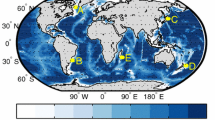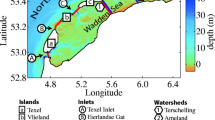Abstract
A simple method for estimating ventilation time scales from overturning stream functions is proposed. The stream function may be computed using either geometric coordinates or a generalized vertical coordinate, such as potential density (salinity in our study). The method is tested with a three-dimensional circulation model describing an idealized semi-enclosed ocean basin ventilated through a narrow strait over a sill, and the result is compared to age estimates obtained from a passive numerical age tracer. The best result is obtained when using the stream function in salinity coordinates. In this case, the reservoir-averaged advection time obtained from the overturning stream function in salinity coordinates agrees rather well with the mean age of the age tracer, and the corresponding maximum ages agree very well.







Similar content being viewed by others
References
Andrews DG, McIntyre ME (1976) Planetary waves in horizontal and vertical shear: the generalized Elise-Palm relation and the mean zonal acceleration. J Atmos Sci 33:2031–2048
Andrews DG, Holton JR, Leovy CB (1987) Middle atmosphere dynamics. Academic Press. 489
Björkström A (1978) A note on the relation between average age and average transit time in natural reservoirs. Tellus 30:185–188
Bolin B, Rodhe H (1973) A note on the concepts of age distribution and residence time in natural reservoirs. Tellus 25:58–62
Bryan K, Sarmiento JL (1985) Modeling ocean circulation. Adv Geophys, A. Climate Dynamics, B. Saltzman (ed.). Academic Press, New York. 28:433–459
Colella P, Woodward PR (1984) The piecewise parabolic method (PPM) for gas dynamical simulations. J Comput Phys 54:174–201
Deleersnijder E, Campin JM, Delhez EJM (2001) The concept of age in marine modelling: I. Theory and preliminary model results. J Mar Syst 28:229–267
Delhez EJM, Deleersnijder E (2002) The concept of age in marine modelling: II. Concentration distribution function in the English Channel and the North Sea. J Mar Syst 31:279–297
Döös K, Nilsson J (2010) Overturning analysis of the meridional energy transport in the atmosphere. J Atmos Sci. doi:10.1175/2010JAS3493.1
Döös K, Meier M, Döscher R (2004) The Baltic haline conveyor belt or the overturning circulation and mixing in the Baltic. Ambio 33:261–266
England MH (1995) The age of water and ventilation time-scales in a global ocean model. J Phys Oceanogr 25:2756–2777
Griffies SM (2007) Elements of MOM4p1. GFDL Ocean Group Technical Report No.6, NOAA, Geophysical Fluid Dynamics Laboratory
Held IM, Schneider T (1999) The surface branch of the zonally averaged mass transport circulation in the troposphere. J Atmos Sci 56:1688–1697
Large WG, McWilliams JC, Doney SC (1994) Oceanic vertical mixing: a review and a model with a nonlocal boundary layer parameterization. Rev Geophys 32:363–403
Lee BS, Bullister JL, Murray JW, Sonnerup RE (2002) Anthropogenic chloroflurocarbons in the black sea of Marmara. Deep Sea Res 1(49):895–913
McDougall TJ, McIntosh PC (1996) The temporal-residual-mean velocity. Part I: derivation and the scalar equations. J Phys Oceanogr 26:2653–2665
McIntosh PC, McDougall TJ (1996) Isopycnal averaging and the residual mean circulation. J Phys Oceanogr 26:1655–1660
Merryfield WJ, Holloway G (2003) Application of an accurate advection algorithm to sea-ice modelling. Ocean Model 5:1–15
Monsen NE, Cloern JE, Lucas LV, Monismith SG (2002) A comment on the use of flushing time, residence time and age as transport time scales. Limnol Oceanogr 47(5):1545–1553
Nycander J, Broström G, Nilsson J, Döös K (2007) Thermodynamic analysis of the ocean circulation. J Phys Oceanogr 37:2038–2052
Plumb AR (2007) Tracer interrelationships in the stratosphere. Rev Geophys 45, RG4005. doi:10.1029/2005RG000179
Prather M (1986) Numerical advection by conservation of second-order moments. J Geophys Res 91:6671–6681
Rudels B (1995) The thermohaline circulation of the Arctic Ocean and the Greenland Sea. Phil Trans Phys Sci Eng 352:287–299
Stanev EV (2005) Understanding Black Sea dynamics: overview of recent numerical modelling. Oceanography 18(2):52–71
Thompson B, Nilsson J, Nycander J, Jakobsson M, Döös K (2010) Ventilation of the miocene arctic ocean: an idealized model study. Paleoceanography. doi:10.1029/2009PA001883
Thompson B, Jakobsson M, Nilsson J, Nycander J, Döös K (2012) A model study of the first ventilated regime of the Arctic Ocean during the early Miocene. Polar Res 31:10859. doi:10.3402/polar.v31i0.10859
Townsend RD, Johnson DR (1985) A diagnostic study of the isentropic zonally averaged mass circulation in the first GARP global experiment. J Atmos Sci 42:1565–1579
Zimmerman JTF (1988) Estuarine residence times. In B. Kjerfve (ed) Hydrodynamics of estuaries, V. I. CRC Press. 75–84.
Acknowledgments
This work was supported by the Bolin Centre for Climate Research, Stockholm University, Sweden, and by the Swedish Research Council, grant 2008-4400. The model integrations were done on the Linux cluster ‘Tornado’ at the National Supercomputer Center in Sweden (NSC), and the support from NSC staff is acknowledged. We also thank Richard D. Slater, Princeton University, for the discussions regarding the implementation of age tracer in the model. Figures were drawn using Ferret.
Author information
Authors and Affiliations
Corresponding author
Additional information
Responsible Editor: Eric Deleersnijder
Appendix 1
Appendix 1
1.1 Relation between mean age and turnover time
Bolin and Rodhe (1973) showed that the average transit time (i.e., the average age of the exiting fluid particles) is equal to the turnover time at a steady state. Björkström (1978) noted that the ratio between the average age and the average transit time of the fluid particles in a reservoir increases with increasing standard deviation in the transit-time distribution. From this, he was able to show that the average age of the fluid particles in the reservoir is at least half of the turnover time.
We will now show that the corresponding result holds also for an age tracer, which is affected by diffusion. The equation for the tracer distribution is obtained from Eq. (1) at a steady state,
By integrating Eq. (A1) over the basin, we get
where d A is the cross-sectional area in the strait. The only contribution to the integral on the left-hand side comes from the outflow, since τ = 0 in the incoming fluid. Thus, dividing Eq. (A2) by the total outflow F 0 from the basin, we obtain
where \( {\tau}_t=\frac{1}{F_0}{\displaystyle \underset{\mathrm{out}}{\int}\tau \mathbf{u}\cdot d\mathbf{A}} \) is the average transit time. The diffusive age flux through the strait, i.e., the first term on the right-hand side of Eq. (A3), is negative, since τ = 0 outside the domain, hence τ t < τ 0. If we neglect this diffusive flux, we recover the result by Bolin and Rodhe (1973) that the mean transit time is equal to the turnover time, τ t = τ 0.
We then multiply Eq. (A1) by τ and integrate. After a partial integration, we obtain
The left-hand side can be rewritten as
The second term on the right-hand side here vanishes identically. Thus, dividing Eq. (A4) by V 0 and rearranging the terms, we obtain
Again, neglecting the diffusive flux through the strait, we can neglect the last term in Eq. (A6) and use the relation τ t = τ 0 from Eq. (A3), which gives
Hence,
Note that in order to derive this result, we neglected the diffusive flux through the strait, but not the diffusion and mixing in the interior of the basin, which gives rise to the last term in Eq. (A7).
If we set τ = 0 exactly at the boundary, ∇τ must be large at the outflow, and we cannot neglect the diffusive flux across the boundary. Near the boundary there is a thin boundary layer, with thickness of order κ/u, in which there is an advective–diffusive balance. The derivation above is valid if the age of the outflowing water is measured just inside this boundary layer.
Rights and permissions
About this article
Cite this article
Thompson, B., Nycander, J., Nilsson, J. et al. Estimating ventilation time scales using overturning stream functions. Ocean Dynamics 64, 797–807 (2014). https://doi.org/10.1007/s10236-014-0726-5
Received:
Accepted:
Published:
Issue Date:
DOI: https://doi.org/10.1007/s10236-014-0726-5




